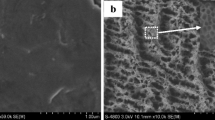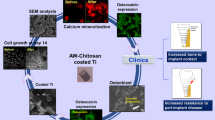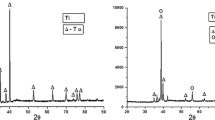Abstract
Attempts are ongoing to improve the surface properties of dental implants by application of different coatings, aiming to enhance osseointegration, and decrease the adverse effects of titanium and its alloys used in dental implants. Coating of implant surface with hydroxyapatite (HA) is one suggested strategy for this purpose due to its high biocompatibility and similar structure to the adjacent bone. This study aimed to quantify the release of silver ions and expression of osteogenic genes by MC3T3-E1 cells cultured on nano-HA and silver/strontium (Ag/Sr)-coated titanium plates via the electrochemical deposition method. Plates measuring 10 × 10 × 0.9 mm were fabricated from Ti-6Al-4 V alloy, and polished with silicon carbide abrasive papers before electrochemical deposition to create a smooth, mirror-like surface. After applying homogenous nano-HA coatings with/without silver/strontium on the surface of the plates, the composition of coatings was confirmed by energy-dispersive X-ray spectroscopy (EDS), and their morphological properties were analyzed by scanning electron microscopy (SEM). The coated specimens were then immersed in simulated body fluid (SBF), and the concentration of released sliver ions was quantified by spectroscopy at 7–14 days. The MC3T3-E1 osteoblastic cell line was cultured in osteogenic medium for 7–14 days, and after RNA extraction and cDNA synthesis, the expression of runt-related transcription factor 2 (RUNX2), osteocalcin (OCN), and osteopontin (OPN); osteogenic genes was quantified by polymerase chain reaction (PCR) using SYBR Green Master Mix kit. The expression of genes and the released amount of silver ions were compared between the two groups using the Mann–Whitney U test. The two groups were not significantly different regarding silver ion release at 14 days (P > 0.05). However, silver ion release was significantly higher from nano-HA coatings with silver/strontium at 7 days (P = 0.03). The difference in expression of RUNX2 (P = 0.04), OPN (P = 0.04), and OCN (P = 0.03) genes was also significant between nano-HA coating groups with and without silver/strontium at 7 days, and the expressions were higher in nano-HA with silver/strontium group, but this difference was not significant at 14 days. Addition of silver and strontium to specimens coated with nano-HA increased the release of silver ions within the non-toxic range, and enhanced the expression of osteogenic genes particularly after 7 days.


Similar content being viewed by others
Data availability
The datasets obtained and analyzed during the current study are available from the corresponding author upon reasonable request.
Abbreviations
- HA:
-
Hydroxyapatite
- Ag/Sr:
-
Silver/Strontium
- EDS:
-
Energy-Dispersive X-ray Spectroscopy
- SEM:
-
Scanning Electron Microscopy
- SBF:
-
Simulated Body Fluid
- RUNX2:
-
Runt-Related Transcription Factor 2
- OCN:
-
Osteocalcin
- OPN:
-
Osteopontin
- PCR:
-
Polymerase Chain Reaction
References
Ambard AJ, Mueninghoff L. Calcium phosphate cement: Review of mechanical and biological properties. J Prosthodont. 2006;15:321–8.
Brunette DM, Tengvall P, Textor M TP, Textor M, Thomsen P. (2013) Titanium in medicine: material science, surface science, engineering, biological responses and medical applications. Springer Sci Bus Media 13–24.
Bernardi S, Bianchi S, Tomei AR, Continenza MA, Macchiarelli G. Microbiological and SEM-EDS evaluation of titanium surfaces exposed to periodontal gel. In Vitro Study Mater (Basel). 2019;12(9):1448.
Kula Z, Semenov M, Klimek L. Carbon coatings deposited on prosthodontic Ni-Cr alloy. Appl Sci. 2021;11(10):4551.
Prodanov L, Lamers E, Domanski M, Luttge R, Jansen JA, Walboomers XF. The effect of nanometric surface texture on bone contact to titanium implants in rabbit tibia. Biomaterials. 2013;34:2920–7.
Bral A, Mommaerats MY. In vivo bio-functionalization of titanium patient-specific implants with nano-hydroxyapatite and other nano-calcium phosphate coatings: a systematic review. J Cranio-maxillofac Surg. 2016;44:400–12.
Webster TJ, Ejiofor JU. Increased osteoblast adhesion on nano-phase metals: Ti, Ti-6Al-4V, and CoCrMo. Biomaterials. 2004;25:4731–9.
Gopi D, Shinyjoy E, Kavitha L. Synthesis and spectral characterization of silver/magnesium co-substituted hydroxyapatite for biomedical applications. Spectrochim Acta Part A Mol Biomol Spectrosc. 2014;127:286–91.
Lv M, Su S, He Y, Huang Q, Hu W, Li D, Fan C, Lee ST. Long-term antimicrobial effect of silicon nanowires decorated with silver nanoparticles. Adv Mater. 2010;22:5463–7.
Zhou JH, Li B, Lu SM, Zhang L, Han Y. Regulation of osteoblast proliferation and differentiation by interred spacing of Sr-HA nanorods on microporous titania coating. ACS Appl Mater Int. 2013;5:5358–65.
Wong KL, Wong CT, Liu WC, Pan HB, Fong MK, Lam WM, Cheung WL, Tang WM, Chiu KY, Luk KDK, Lu WW. Mechanical properties and in vitro response of strontium-containing hydroxyapatite/polyetherether-ketone composites. Biomaterials. 2009;30:3810–7.
Roy M, Fielding GA, Beyenal H, Bandyopadhyay A, Bose S. Mechanical in vitro antimicrobial, and biological properties of plasma sprayed silver doped hydroxyapatite coating. ACS Appl Mater Interfaces. 2012;4(3):1341–9.
El-Wassefy NA, Reicha FM, Aref NS. Electrochemical deposition of nano hydroxyapatite-zinc coating on titanium metal substrate. Int J Implant Dent. 2017;3:39–50.
Geng Z, Wang R, Zhuo X, Li Z, Huange Y, Ma L, Cuia Z, Zhu S, Liang Y, Liu Y, Bao H, Li X, Huo Q, Liu Z, Yang X. Incorporation of silver and strontium in hydroxyapatite coating on titanium surface for enhanced antibacterial and biological properties. Mater Sci Eng. 2017;71:852–61.
Huang Y, Zhang X, Zhang H, Qiao H, Zhang X, Jia T, Han S, Gao Y, Xiao H, Yang H. Fabrication of silver- and strontium-doped hydroxyapatite/ TiO2 nanotube bilayer coatings for enhancing bactericidal effect and osteoinductivity. Ceramics Int. 2017;43(1):992–1007.
Fu C, Zhang X, Savino K, Gabrys P, Gao Y, Chaimayo W, Miller BL, Yates MZ. Antimicrobial silver hydroxyapatite composite coatings through two-stage electro-chemical synthesis. J Ceramics. 2016;301:13–9.
Liang Y, Li H, Xu J, Li X, Li X, Yan Y, Qi M, Hu M. Strontium coating by electrochemical deposition improves implant osseointegration in osteopenic models. Exp Ther Med. 2015;9:172–6.
Shimazaki T, Miyamoto H, Ando Y, Noda I, Yonekura Y, Kawano S, Miyazaki M, Mawatari M, Hotokebuchi T. In vivo antibacterial and silver-releasing properties of novel thermal sprayed silver-containing hydroxy-apatite coating. J Biomed Mater Res B Appl Biomater. 2010;92(2):386–9.
Chen Y, Zheng X, Xie Y, Ji H, Ding C, Li H, Dai K. Silver release from silver-containing hydroxyapatite coatings. Surf Coat Technol. 2010;205:1892–6.
Fu C, Savino K, Gabrys P, Zeng A, Guan B, Olvera D, et al. Hydroxyapatite thin films with giant electrical polarization. Chem Mater. 2015;27:1164–71.
Bartmanski M, Cieslik B, Glodowska J, Kalka P, Pawloski L, Pieper M, Zielingski A. Electrophoretic deposition (EPD) of nanohydroxyapatite- nano-silver coatings on Ti13Zr13Nb alloy. Ceramics Int. 2017;43:11820–9.
Erdem U, Turkoz MB. Silver release of Ag (I) doped hydroxyapatite: In vitro study. Microsc Res Tech. 2019;82(7):961–71.
Mirzaee M, Vaezi M, Palizdar Y. Synthesis and characterization of silver doped hydroxyapatite nano-composite coatings and evaluation of their antibacterial and corrosion resistance properties in simulated body fluid. Mater Sci Eng C. 2016;69:675–84.
Zhu Z-Y, Zhang F-Q, Zheng X-B. Study on the slow release of silver ion from silver containing antibacterial HA coating material. Shanghai Kou Qiang Yi Xue. 2009;18(1):66–8.
Fielding GA, Roy M, Bandyopadhyay A, Bose S. Antibacterial and biological characteristics of silver containing and strontium doped plasma sprayed hydroxyl-apatite coatings. Acta Biomater. 2012;8:3144–52.
Geng Z, Cui ZD, Li ZY, Zhu SL, Liang YQ, Liu YD. Strontium incorporation to optimize the antibacterial and biological characteristics of silver-substituted hydroxyl-apatite coating. Mater Sci Eng C. 2016;58:467–77.
Guo X, Gough JE, Xiao P, Liu J, Shen Z. Fabrication of nanostructured hydroxyapatite and analysis of human osteoblastic cellular response. J Biomed Mater Res A. 2007;82:1022–32.
Matsumoto N, Sato K, Yoshida K, Hashimoto K, Toda Y. Preparation and characterization of β-tricalcium phosphate co-doped with monovalent and divalent antibacterial metal ions. Acta Biomater. 2009;5:3157–64.
Song WH, Ryu HS, Hong SH. Antibacterial properties of Ag (or Pt)-containing calcium phosphate coatings formed by micro-arc oxidation. J Biomed Mater Res. 2009;88A:246–54.
Hata K, Kokubo T, Nakamura T, Yamamuro T. Growth of a bonelike apatite layer on a substrate by a biomimetic process. J Am Ceram Soc. 1995;78(4):1049–53.
Bonnelye E, Chabadel A, Saltel F, Jurdic P. Dual effect of strontium ranelate: stimulation of osteoblast differentiation and inhibition of osteoclast formation and resorption in vitro. Bone. 2008;42:129–38.
Ni GX, Yao ZP, Huang GT, Liu WG, Lu WW. The effect of strontium incorporation in hydroxyapatite on osteoblasts in vitro. J Mater Sci Mater Med. 2011;22:961–7.
Choudhary S, Halbout P, Alander C, Raisz L, Pilbeam C. Strontium ranelate promotes osteoblastic differentiation and mineralization of murine bone marrow stromal cells: involvement of prostaglandins. J Bone Miner Res. 2007;22:1002–10.
Gotoh Y, Hiraiwa K, Nagayama M. In vitro mineralization of osteoblastic cells derived from human bone. Bone Miner. 1990;8(3):239–50.
Stein GS, Lian JB, Owen TA. Relationship of cell growth to the regulation of tissue-specific gene expression during osteoblast differentiation. FASEB J. 1990;4:3111–23.
Capuccini C, Torricelli P, Sima F. Strontium-substituted hydroxyapatite coatings synthesized by pulsed-laser deposition: in vitro osteoblast and osteoclast response. Acta Biomater. 2008;4:1885–93.
Caverzasio J, Thouverey C. Activation of FGF receptors is a new mechanism by which strontium ranelate induces osteoblastic cell growth. Cell Physiol Biochem. 2011;27:243–50.
Baier M, Staudt P, Klein R. Strontium enhances osseointegration of calcium phosphate cement: a histomorphometric pilot study in ovariectomized rats. J Orthop Surg Res. 2013;8:16.
Pan HB, Zhao XL, Zhang X. Strontium borate glass: potential biomaterial for bone regeneration. J R Soc Interface. 2010;7:1025–31.
Xuejiao Z, Bingbing W, Lifei M, Lei X, Hao Y, Yichao L, Saisai W, Haixia Q, He L, Jingpin L, Yong H. Chemical stability, antibacterial and osteogenic activities study of strontium-silver co-substituted fluorohydroxyapatite nanopillars: a potential multifunctional biological coating. Ceram Int. 2020;17:27758–73.
Bernardi S, Macchiarelli G, Bianchi S. Autologous Materials in Regenerative Dentistry: Harvested Bone, Platelet Concentrates and Dentin Derivates. Molecules. 2020;25(22):5330.
Bianchi S, Mancini L, Torge D, Cristiano L, Mattei A, Varvara G, Macchiarelli G, Marchetti E, Bernardi S. Bio-Morphological Reaction of Human Periodontal Ligament Fibroblasts to Different Types of Dentinal Derivates: In Vitro Study. International Journal of Molecular Sciences. 2021; 22(16):8681.
Acknowledgements
The authors gratefully acknowledge the financial support for this work that was provided by Research Institute for Dental Sciences, Shahid Beheshti University of Medical Sciences.
Funding
This research was supported by Research Institute for Dental Sciences, Shahid Beheshti University of Medical Sciences.
Author information
Authors and Affiliations
Contributions
A.L. and A.E.N. conceived the study; M.R.R. and T.S. performed the experiments; M.N. analyzed the data; A.L. and T.S. wrote the manuscript. All authors have read and approved the final manuscript.
Corresponding author
Ethics declarations
Conflict of interests
The authors have declared that No competing interests exist.
Ethics approval and consent to participate
This study was approved by the Research Institute of Dental Sciences (Shahid Beheshti University of Medical Sciences) Ethics Committee (approval number 161).
Consent for publication
Not applicable.
Additional information
Publisher's Note
Springer Nature remains neutral with regard to jurisdictional claims in published maps and institutional affiliations.
Rights and permissions
Springer Nature or its licensor holds exclusive rights to this article under a publishing agreement with the author(s) or other rightsholder(s); author self-archiving of the accepted manuscript version of this article is solely governed by the terms of such publishing agreement and applicable law.
About this article
Cite this article
Lafzi, A., Esmaeil Nejad, A., Rezai Rad, M. et al. In vitro release of silver ions and expression of osteogenic genes by MC3T3-E1 cell line cultured on nano-hydroxyapatite and silver/strontium-coated titanium plates. Odontology 111, 33–40 (2023). https://doi.org/10.1007/s10266-022-00747-z
Received:
Accepted:
Published:
Issue Date:
DOI: https://doi.org/10.1007/s10266-022-00747-z




